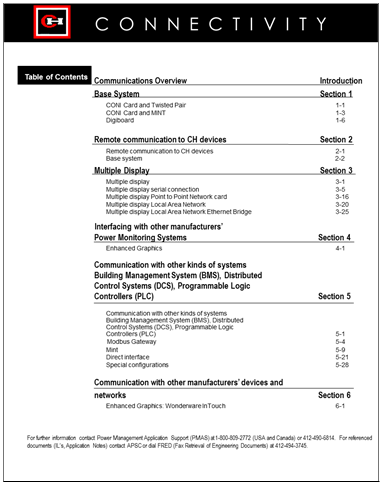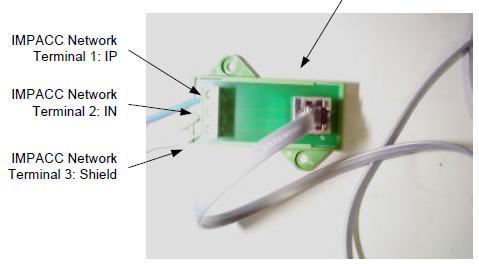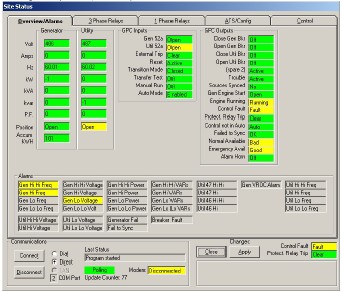- Welcome to LEC Forum.
Recent posts
#71
INCOM / IMPACC / Wiring Guide
Last post by Dave Loucks - April 11, 2012, 08:49:48 AMINCOM / EIA-485 / Ethernet Recommended Wiring Practices for Eaton Equipment
http://www.eaton.com/ecm/groups/public/@pub/@electrical/documents/content/td17513_appnote.pdf
http://www.eaton.com/ecm/groups/public/@pub/@electrical/documents/content/td17513_appnote.pdf
#72
INCOM / IMPACC / INCOM versus RS-485
Last post by Dave Loucks - April 11, 2012, 08:48:24 AMINCOM was invented by Westinghouse as a method of transmitting serial data down wires that would be in close proximity to high power conductors. Characteristics of INCOM included:
The earliest 1200 bps INCOM networks operated by transmitting a 115.2 kHz tone to represent a binary 1 bit and absence of tone to indicate a binary 0 bit. Since a relatively high frequency tone was chosen, a transformer was used to couple the board electronics to the network. This provided ~1500 V isolation node to node and node to ground from the network. A bandpass filter was used to detect the 115.2 kHz tone, which offered good noise rejection. At the 1200 bps signalling rate, 96 cycles of 115.2 kHz represented one bit on the INCOM data packet, which offered good oversampling / redundancy, again increasing the signal to noise ratio.
Later, the network was upgraded to 9600 bps. The faster signaling rate meant that only about 12 bits of the 115.2 kHz signal represented a single INCOM bit. Since the tone oscillator had to be switched on and off, the natural ramp up and ramp down of the signal essentially meant that the first and last few cycles of the 110 kHz tone would not be exactly on frequency. This reduced the amount of oversampling and reduced the reliability of the network at 9600. The solution to this problem was to keep the tone oscillator switched on, but make it a voltage controlled oscillator (VCO) and have the binary zero represent a different tone sufficiently separated from the binary 1 tone, but not so far away as to make slewing to and from the binary 1 tone excessively difficult. The second tone chosen was 92 kHz
What is the difference between INCOM and EIA-485 (formerly known as RS-485), a more common physical layer?
* The EIA-485 standard does not include galvanic isolation, but a separate dc/dc power supply and opto-isolation can be added to provide isolation. 485 driver chips can be purchased that include this isolation built in.
For a discussion of noise immunity differences, see this document:
http://pps2.com/communications/files/INCOM/485vsINCOM.ppt
- Galvanic isolation between nodes
- Frequency shift keying
- Polarity insensitive
- Tolerance for wiring with T's, Y's, taps and branches
- Essentially unlimited number of nodes per cable (1000 listed as tested max.)
- 10000 feet (3000 m) end to end distance without repeaters
The earliest 1200 bps INCOM networks operated by transmitting a 115.2 kHz tone to represent a binary 1 bit and absence of tone to indicate a binary 0 bit. Since a relatively high frequency tone was chosen, a transformer was used to couple the board electronics to the network. This provided ~1500 V isolation node to node and node to ground from the network. A bandpass filter was used to detect the 115.2 kHz tone, which offered good noise rejection. At the 1200 bps signalling rate, 96 cycles of 115.2 kHz represented one bit on the INCOM data packet, which offered good oversampling / redundancy, again increasing the signal to noise ratio.
Later, the network was upgraded to 9600 bps. The faster signaling rate meant that only about 12 bits of the 115.2 kHz signal represented a single INCOM bit. Since the tone oscillator had to be switched on and off, the natural ramp up and ramp down of the signal essentially meant that the first and last few cycles of the 110 kHz tone would not be exactly on frequency. This reduced the amount of oversampling and reduced the reliability of the network at 9600. The solution to this problem was to keep the tone oscillator switched on, but make it a voltage controlled oscillator (VCO) and have the binary zero represent a different tone sufficiently separated from the binary 1 tone, but not so far away as to make slewing to and from the binary 1 tone excessively difficult. The second tone chosen was 92 kHz
- Binary 1: 110 kHz
- Binary 0: 92 kHz (9600 bps mode), no tone (1200 bps mode)
- Message: 33 bits
- Start Bit: 2 bits
- Control Bit: 1 bit
- Data: 24 bits
- BHC Check: 5 bits code
What is the difference between INCOM and EIA-485 (formerly known as RS-485), a more common physical layer?
| INCOM | EIA-485 | |
| Galvanic Isolation | Transformer | * |
| Number of Nodes | 1000 per segment | 32 per segment |
| Wiring T's, Y's taps permitted? | Yes | No |
For a discussion of noise immunity differences, see this document:
http://pps2.com/communications/files/INCOM/485vsINCOM.ppt
#73
INCOM / IMPACC / Connectivity Guide - Pre-1999
Last post by Dave Loucks - April 11, 2012, 08:07:59 AMHere's a copy of the connectivity guide that was published shortly before the systems integration group was moved from the PMP Center to EESS.
http://pps2.com/communications/files/INCOM/Cnctvty2.ppt

http://pps2.com/communications/files/INCOM/Cnctvty2.ppt
#74
INCOM / IMPACC / Phoenix Contact UMK-SE 11,25-1...
Last post by Dave Loucks - April 11, 2012, 08:00:10 AMThe adapter was used with the CONI card. Since the CONI card only had an RJ-11 connection, this adapter was used to fan-out the RJ-11 into a twisted pair terminal strip.

#75
HMI/Video / VGA Pinouts
Last post by Dave Loucks - April 11, 2012, 07:55:59 AMThe standard pinouts for the 15-pin D-shell connector that connects VGA, XGA, etc. monitors to a standard "VGA" video card:

#76
Product Tech Support / Tech Support
Last post by Dave Loucks - April 10, 2012, 07:21:32 AMWhile you have to register to be able to leave a message on this board, you can always contact Eaton directly with your technical questions.
Technical Resource Center
The Technical Resource Center provides product selection, application and general technical support for Eaton electrical products:
To reach an EatonCare representative, please call: (877) ETN CARE or (877) 386-2273.
Crisis Response
7x24 emergency support: Web Site for more information.
North America: 1-800-498-2678
Power Quality (UPS, Air Flow Management, Rack Power Distribution)
Tech Support: Web Site for more information.
Technical Resource Center
The Technical Resource Center provides product selection, application and general technical support for Eaton electrical products:
To reach an EatonCare representative, please call: (877) ETN CARE or (877) 386-2273.
Crisis Response
7x24 emergency support: Web Site for more information.
North America: 1-800-498-2678
Power Quality (UPS, Air Flow Management, Rack Power Distribution)
Tech Support: Web Site for more information.
#77
Encorp GPC / Encorp GPC Programming
Last post by Dave Loucks - April 09, 2012, 07:52:45 PMThe typical method of programming the GPC was to use the software provided by Encorp. This software connected to the GPC using the Lonworks LonTalk protocol. Since LonTalk required an external converter (usually RS-232 to LonTalk twisted pair), some users requested an alternate method of changing setpoints that did not require the LonTalk gateway.
Since the GPC also included a Modbus RS-485 port and since many of the setpoints within the GPC were memory mapped within the Modbus register map, changing setpoints via Modbus is possible.
A simple program loader that used the Modbus protocol was developed that can be downloaded from http://www.pps2.com/communications/DGMonitor.htm.

A user manual explaining how to use this software can be reviewed http://www.pps2.com/communications/files/DGHelp.doc.
The source code for the VB 6.0 application can be downloaded here:
http://www.pps2.com/communications/files/DGMonitorSourceCode.zip
Complete Cross Reference of LonWorks SNVTs to Modbus Registers used in GPC:
http://pps2.com/communications/files/GPC/rev2-0%20control%20variables.xls
(Limited) Cross Reference of SNVT to Modbus Register used in this VB Program:
http://pps2.com/communications/files/GPC/Tagname%20Cross-Ref.xls
Since the GPC also included a Modbus RS-485 port and since many of the setpoints within the GPC were memory mapped within the Modbus register map, changing setpoints via Modbus is possible.
A simple program loader that used the Modbus protocol was developed that can be downloaded from http://www.pps2.com/communications/DGMonitor.htm.

A user manual explaining how to use this software can be reviewed http://www.pps2.com/communications/files/DGHelp.doc.
The source code for the VB 6.0 application can be downloaded here:
http://www.pps2.com/communications/files/DGMonitorSourceCode.zip
Complete Cross Reference of LonWorks SNVTs to Modbus Registers used in GPC:
http://pps2.com/communications/files/GPC/rev2-0%20control%20variables.xls
(Limited) Cross Reference of SNVT to Modbus Register used in this VB Program:
http://pps2.com/communications/files/GPC/Tagname%20Cross-Ref.xls
#78
Numa Logic Programmable Controllers / HPPC (High Performance Program...
Last post by Dave Loucks - April 09, 2012, 07:02:39 PMAs those who worked with with the HPPC 1500 or 1700 systems recall, the programming software and programming methodology are different for the HPPC compared with the PC700, 900, 1100 and 1200 processors.
Refer to http://www.pps2.com/communications/799.php and download the HPPC programming (APL or Advanced Program Loader) manual as well as the HPPC Systems Manual and the HPPC Systems Manual supplement for more information on those differences.
Refer to http://www.pps2.com/communications/799.php and download the HPPC programming (APL or Advanced Program Loader) manual as well as the HPPC Systems Manual and the HPPC Systems Manual supplement for more information on those differences.
#79
First Time Visitor / Welcome
Last post by Dave Loucks - April 09, 2012, 12:53:38 PMThis forum provides technical information on connectivity, communications, software and systems integration regarding both current and legacy Eaton and Westinghouse communicating products. It also includes general technical documentation about topics that I've encountered over my career.
After I retired from Eaton I took over the maintenance of this site.
You are encouraged to click around the board. Use the search function to look up a topic.
The button for search is at the top of each page.
We have switched off the acceptance of new member registration due to spam problems. Sorry about that.
If you have any questions, just message me via email or LinkedIn.
Dave Loucks
dgl@lec.engineer
https://lec.engineer
https://www.linkedin.com/in/dgloucks/
After I retired from Eaton I took over the maintenance of this site.
You are encouraged to click around the board. Use the search function to look up a topic.
The button for search is at the top of each page.
We have switched off the acceptance of new member registration due to spam problems. Sorry about that.
If you have any questions, just message me via email or LinkedIn.
Dave Loucks
dgl@lec.engineer
https://lec.engineer
https://www.linkedin.com/in/dgloucks/
#80
INCOM / IMPACC / INCOM Protocol Documentation
Last post by Dave Loucks - April 05, 2012, 10:24:01 AMIf you wanted to dig deep into the INCOM protocol, here are the detailed documents from the Eaton web site:
Here's some more information on other INCOM networking devices:
- IL 17384 Part A IMPACC Communications Standard
http://www.eaton.com/ecm/groups/public/@pub/@electrical/documents/content/1030709222496.pdf
(Note: 2011 Version of this document is available here.) - IL 17384 Part B Metering Products
http://www.eaton.com/ecm/groups/public/@pub/@electrical/documents/content/il17384b.pdf - IL 17384 Part C Protective Relays and Trip Units
http://www.eaton.com/ecm/groups/public/@pub/@electrical/documents/content/il17384c.pdf
(Note: a more up-to-date version of the protocol document for the Digitrip 520MC and the Digitrip 1150 is attached below) - IL 17384 Part D Motor Protection and Control
http://www.eaton.com/ecm/groups/public/@pub/@electrical/documents/content/il17384d.pdf - IL 17384 Part E Panel-Mounted Operator Interfaces http://www.eaton.com/ecm/groups/public/@pub/@electrical/documents/content/il17384e.pdf
- IL 17384 Part F Transfer Switches and I/O Devices http://www.eaton.com/ecm/groups/public/@pub/@electrical/documents/content/il17384f.pdf
Here's some more information on other INCOM networking devices:
- Modbus MINT Instruction Leaflet
http://www.eaton.com/Electrical/USA/ProductsandServices/PowerQualityandMonitoring/NetworkingHardware/mMINT/index.htm - Modbus MINT Application Note
http://pps2.com/communications/files/INCOM/mMINT%20App%20Note%20R04.pdf - Profibus MINT
http://www.eaton.com/Electrical/USA/ProductsandServices/PowerQualityandMonitoring/NetworkingHardware/PMINT/index.htm - DeviceNet PONI
http://www.eaton.com/Electrical/USA/ProductsandServices/PowerQualityandMonitoring/NetworkingHardware/DPONI/index.htm - Modbus PONI
http://www.eaton.com/Electrical/USA/ProductsandServices/PowerQualityandMonitoring/NetworkingHardware/ModbusPONI/index.htm - MINT (Modular INCOM Network Translator)
http://www.eaton.com/Electrical/USA/ProductsandServices/PowerQualityandMonitoring/NetworkingHardware/MINTII/index.htm - IPONI (INCOM Product Operated Network Interface)
http://www.eaton.com/Electrical/USA/ProductsandServices/PowerQualityandMonitoring/NetworkingHardware/IPONI/index.htm
